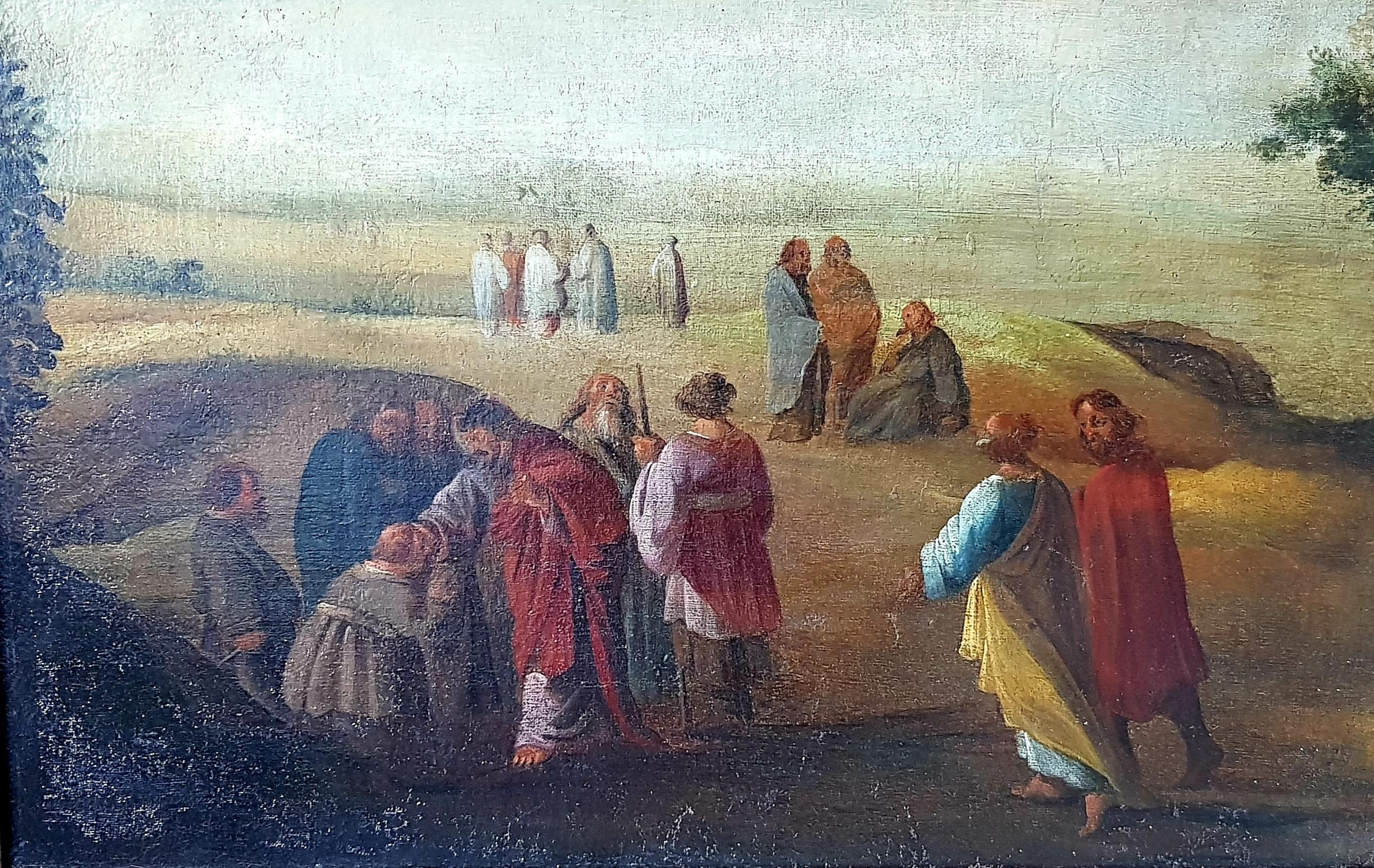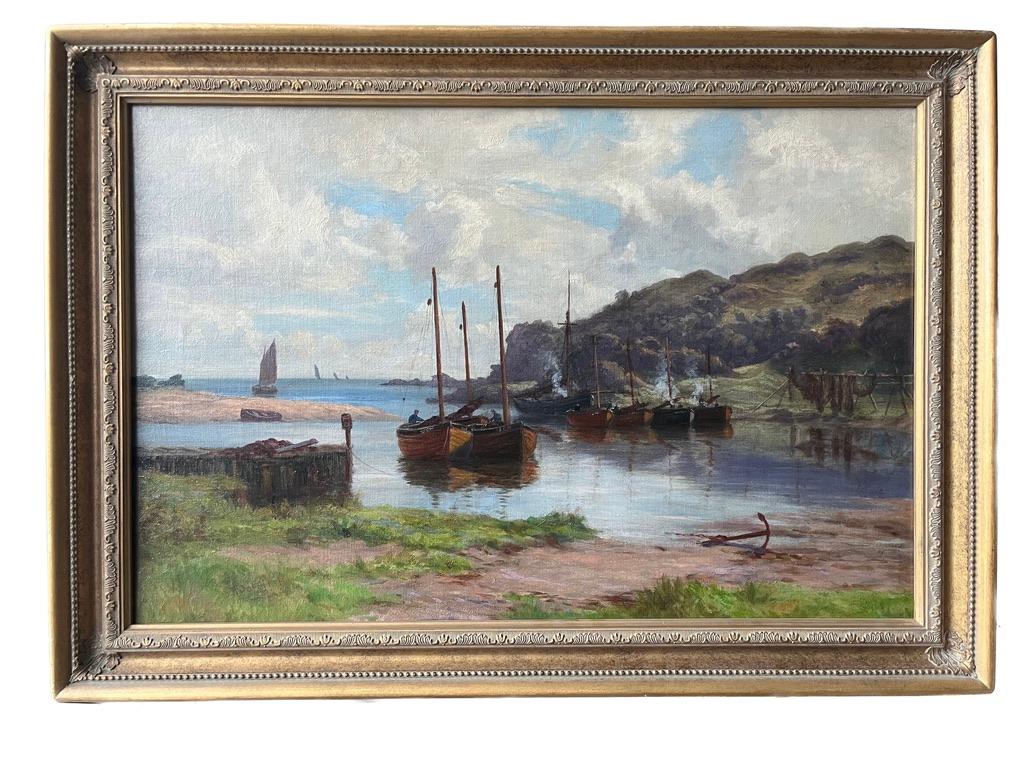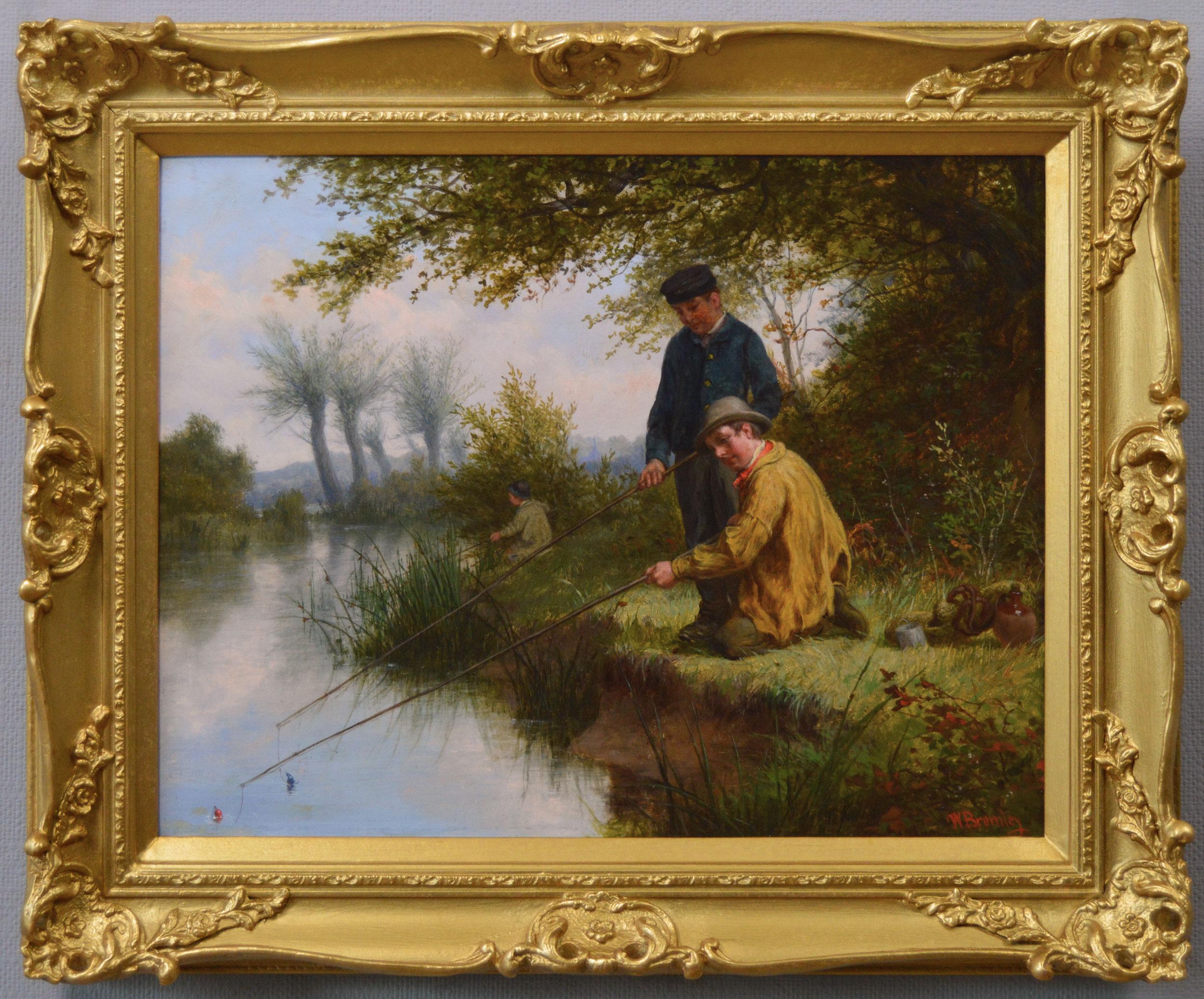Items Similar to Ezekiel in the Valley of Dry Bones
Want more images or videos?
Request additional images or videos from the seller
1 of 6
Philip Burne-JonesEzekiel in the Valley of Dry Bones
About the Item
Provenance:
Christie’s, London, 3 March 1922, lot 46 (with The Tower of Babel);
James Nicoll
Private Collection
Sotheby’s, London, 29 March 1983, lot 157
Private Collection, New York (1983–present)
Exhibited:
The New Gallery, 1888.
Works by Sir Philip Burne-Jones, Bt., The Dowdeswell Galleries, London, April – May 1914.
Literature:
“The Pictures of 1888,” Pall Mall Gazette Extra, no. 41 (1888), p. 77, ill.
Cosmo Monkhouse, “The New Gallery; II,” The Academy, vol. 3, no. 849 (1888), p. 419.
Martin Harrison and Bill Waters, Burne-Jones, London, 1973, p. 180.
Philip Burne-Jones was the only son of Sir Edward Coley Burne-Jones and, like his father, painted from an early age. He was educated at Marlborough and at University College, Oxford, but had little academic success. Philip began to exhibit at the Grosvenor Gallery in 1886 but preferred to show at the New Gallery from its opening two years later, where the present painting first appeared. He produced a few literary pictures at the beginning of his career but specialized in landscapes and portraits. Harrison and Waters have written that Philip “had a talent for portraiture and landscape, and like George Howard, infrequently ventured into imaginative or figure work. Working mostly in gouache or watercolour, once again like Howard, his style could never be confused with his father’s though it approaches it in Ezekiel in the Valley of Dry Bones, which was exhibited at the New Gallery in 1888.”
Philip’s portraits of his father, his uncle Rudyard Kipling, and Sir Edward J. Poynter hang in the National Portrait Gallery, but few of his works are in public collections. His most celebrated painting in his day was The Vampire, an 1897 canvas that was said to inspire a poem by Kipling; its present location is unknown.
Ezekiel in the Valley of Dry Bones is one of the artist’s finest and most evocative paintings. The subject is taken from Ezekiel 37:1-10 (with special reference to 37:2) and is a remarkable portrayal of the Biblical scene. Here Philip follows in the footsteps of his father, with a composition at once mysterious and romantic, and alimited palette here punctuated by the brilliant orange spot of the setting sun. Writing at the time of the New Gallery exhibition, Cosmo Monkhouse described Philip Burne-Jones’s Ezekiel as “the most impressive picture he has yet exhibited.”
When sold in 1922, Ezekiel in the Valley of Dry Bones was paired with another painting by the artist, The Tower of Babel. That work, dated 1889, is at present lost, having last appeared at auction at Sotheby’s, Belgravia, 6 December 1977, lot 100.
- Creator:Philip Burne-Jones (1861 - 1926, British)
- Dimensions:Height: 23 in (58.42 cm)Width: 18 in (45.72 cm)
- Medium:
- Movement & Style:
- Period:
- Condition:
- Gallery Location:New York, NY
- Reference Number:1stDibs: LU1021074663

About the Seller
5.0
Recognized Seller
These prestigious sellers are industry leaders and represent the highest echelon for item quality and design.
Established in 1997
1stDibs seller since 2012
17 sales on 1stDibs
Typical response time: 11 hours
- ShippingRetrieving quote...Ships From: New York, NY
- Return PolicyThis item cannot be returned.
More From This SellerView All
- Two Scenes of Diana and Actaeon (a pair)By Giovanni Battista ViolaLocated in New York, NYProvenance: Robert L. and Bertina Suida Manning, New York, until 1996 Private Collection, USA Giovanni Battista Viola was born in Bologna a...Category
17th Century Baroque Landscape Paintings
MaterialsCopper
- Madonna and Child with Angels in the CloudsLocated in New York, NYProvenance: Charles H. and Virginia Baldwin, Claremont, Colorado Springs, Colorado ca. 1907-1934; thence by descent until sold in 1949 to: Charles Blevins Davis, Claremont (renamed Trianon), Colorado Springs 1949 -until gifted in 1952 to: The Poor Sisters of Saint Francis, Trianon, Colorado Springs, 1952 until acquired, 1960, by: John W. Metzger, Trianon, renamed as the Trianon School of Fine Arts, Colorado Springs, 1960-1967; when transferred to: The Metzger Family Foundation, Trianon Art Museum, Denver, 1967 - 2004; thence by descent in the Metzger Family until 2015 Exhibited: Trianon Art Museum, Denver (until 2004) The present work is a spectacular jewel-like canvas by Amigoni, rich in delicate pastel colors, most likely a modello for an altarpiece either lost or never painted. In it the Madonna stands firmly upon a cloud in the heavens, her Child resting on a delicate veil further supported by a cloud, as he gently wraps his arm around his mother’s neck. From above angels prepare to lower flowers and a wreath, while other angels and seraphim surrounding the two joyfully cavort. Dr. Annalisa Scarpa, author of the forthcoming monograph on Jacopo Amigoni...Category
18th Century and Earlier Figurative Paintings
MaterialsCanvas, Oil
- Job Cursed by His WifeBy Giovanni Battista LangettiLocated in New York, NYProvenance: Alfred (1883-1961) and Hermine Stiassni (1889-1962), Brno, Czech Republic, by 1925; thence London, 1938-1940; thence Los Angeles, 1940-1962; thence by descent to: Susanne Stiassni Martin and Leonard Martin, San Francisco, until 2005; thence by descent to: Private Collection, California Exhibited: Künstlerhaus, Brünn (Brno), 1925, as by Ribera. “Art of Collecting,” Flint Institute of Art, Flint, Michigan, 23 November 2018 – 6 January 2019. Literature: Alte Meister...Category
1670s Old Masters Paintings
MaterialsCanvas, Oil
- Head of an AngelLocated in New York, NYProcaccini was born in Bologna, but his family moved to Milan when the artist was eleven years old. His artistic education was evidently familial— from his father Ercole and his elder brothers Camillo and Carlo Antonio, all painters—but his career began as a sculptor, and at an early age: his first known commission, a sculpted saint for the Duomo of Milan, came when he was only seventeen years old. Procaccini’s earliest documented painting, the Pietà for the Church of Santa Maria presso San Celso in Milan, was completed by 1604. By this time the artist had made the trip to Parma recorded by his biographers, where he studied Correggio, Mazzola Bedoli, and especially Parmigianino; reflections of their work are apparent throughout Procaccini's career. As Dr. Hugh Brigstocke has recently indicated, the present oil sketch is preparatory for the figure of the angel seen between the heads of the Virgin and St. Charles Borrommeo in Procaccini's altarpiece in the Church of Santa Afra in Brescia (ill. in Il Seicento Lombardo; Catalogo dei dipinti e delle sculture, exh. cat. Milan 1973, no. 98, pl. 113). As such it is the only known oil sketch of Procaccini's that can be directly connected with an extant altarpiece. The finished canvas, The Virgin and Child with Saints Charles Borrommeo and Latino with Angels, remains in the church for which it was painted; it is one of the most significant works of Procaccini's maturity and is generally dated after the artist's trip to Genoa in 1618. The Head of an Angel is an immediate study, no doubt taken from life, but one stylistically suffused with strong echoes of Correggio and Leonardo. Luigi Lanzi, writing of the completed altarpiece in 1796, specifically commented on Procaccini's indebtedness to Correggio (as well as the expressions of the angels) here: “Di Giulio Cesare...Category
17th Century Old Masters Figurative Paintings
MaterialsPaper, Canvas, Oil
- Julius Caesar on HorsebackBy Antonio TempestaLocated in New York, NYProvenance: Private Collection, South America Antonio Tempesta began his career in Florence, working on the decoration of the Palazzo Vecchio under the direction of Giorgio Vasari. He was a pupil first of Santi di Tito...Category
16th Century Old Masters Paintings
MaterialsOil, Canvas
- OrientaleBy Henri Fantin-LatourLocated in New York, NYSigned, lower right: Fantin Provenance: Gustave Tempelaere (1840–1904), Paris; possibly by descent to his son: Julien Tempelaere (1876–1961) and with F. & J. Tempelaere, Paris, prob...Category
1890s Romantic Figurative Paintings
MaterialsPaper, Canvas, Oil
You May Also Like
- 1830's English Oil Storm Clouds Norfolk Landscape Norwich Cathedral River YareBy (Circle of) John ConstableLocated in Cirencester, GloucestershireStorm Clouds over the River Yare *see notes below English School, circa 1830's circle of John Constable (English 1776-187) oil painting on canvas, framed canvas: 18 x 25 inches condi...Category
Early 19th Century Victorian Landscape Paintings
MaterialsCanvas, Oil
- Large Victorian painting of children resting outdoors by J.O. BanksLocated in London, GBLarge Victorian painting of children resting outdoors by J.O. Banks English, late 19th Century Frame: Height 91cm, width 111cm, depth 10cm Can...Category
19th Century Victorian Landscape Paintings
MaterialsCanvas, Oil
- 19th Century seascape oil painting of Penzance harbour, CornwallBy William Edward WebbLocated in Moreton-In-Marsh, GloucestershireWilliam Edward Webb British, (1862-1903) Penzance Harbour Oil on canvas, signed Image size: 29 inches x 45.5 inches Size including frame: 38 inches x 54.5 inches A pleasing coastal painting of Penzance Harbour at low tide by William Edward Webb. In the foreground, a fisherman sells his catch to a woman and her daughter, whilst figures in horses and carts wait for others to unload their boats. William Edward Webb was born in Cheltenham, Gloucestershire in 1862 to William Benjamin Webb and Ellen Butler. His father was a printer and an artist and it is highly likely he received tuition from him. Following the death of his mother, his father remarried and moved the family to Manchester sometime after 1871. By the 1880’s, Webb had started working as an artist and later set up a studio at 30 Exchange Buildings in Manchester. He began exhibiting at the Manchester City Art Gallery from 1890, where he showed more than 60 paintings during his lifetime. He also exhibited at the Royal Academy and Walker Art Gallery Liverpool from 1892. He married Clara Foster in 1899 and the couple lived at 1 Sylvan Grove, Chorlton Upon Medlock in South Manchester with their daughter Florrie. He became friends with the artist Walter Emsley (1860-1938) who also lived in Manchester. Although he spent the rest of his life in Manchester, Webb travelled throughout the UK painting coastal and marine scenes around the main ports and harbours. He spent a great deal of time in the Isle of Mann painting numerous scenes along the coast including views of Peel and Douglas Harbour, subjects he frequently returned to. Webb painted in a highly distinctive style; loose and informal but which manages to retain the sense of perspective. He struggled with ill health and depression throughout his life which sadly led to his suicide 9 November, 1903. In 1974, a retrospective exhibition was held at The Old Customs House and Old Solent House in Lymington, which brought a new found interest in his work. His paintings are now highly sought after and are represented in many collections and Museums including the Astley Hall...Category
19th Century Victorian Landscape Paintings
MaterialsOil, Canvas
- Holy Baptism, Bible Scene, Early 18th Century, Florentine SchoolLocated in Sofia, BGHoly Baptism, Oil painting on canvas by an unknown artist About the artwork: Bible Scene, Early 18th Century, Florentine School TECHNIQUE: oil pai...Category
Early 18th Century Victorian Landscape Paintings
MaterialsOil, Canvas
- Victorian landscape painting of Scottish fishing boats moored in a bayLocated in Harkstead, GBA very tranquil scene of fishing boats moored in harbour with a sunlit sea beyond. Painted with a most attractive palette of blues and greens and with a pleasing composition that le...Category
19th Century Victorian Landscape Paintings
MaterialsOil, Canvas
- 19th Century genre landscape oil painting of three boys fishing on a riverBy William BromleyLocated in Moreton-In-Marsh, GloucestershireWilliam Bromley British, (1816-1890) Gone Fishing Oil on canvas, signed Image size: 13.5 inches x 17.5 inches Size including frame: 18.75 inches x 22.75 inches A picturesque genr...Category
19th Century Victorian Figurative Paintings
MaterialsOil, Canvas
Recently Viewed
View AllMore Ways To Browse
Howard And Son Style
19th Century Oil Portrait Pairs
Pair 19th Century Oil Portrait Paintings
Pair Of 19th Century Oil Portraits
Oil Literary Portrait
J Bonal
Harrison And Son
Bill Martin
Howard Jones
Howard Pair Sons
The Vampire
April Harrison
George Waters
Babel Tower
Tower Of Babel
Philip Jones
Belgravia London
Pall Mall Oil





